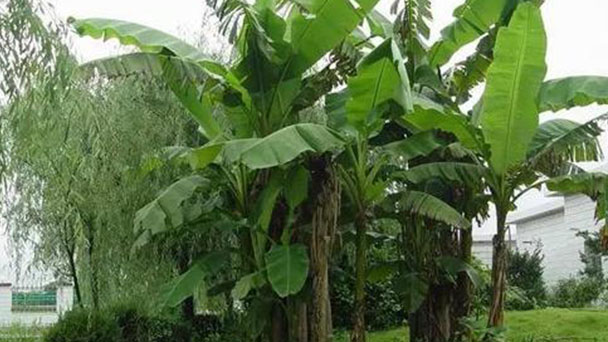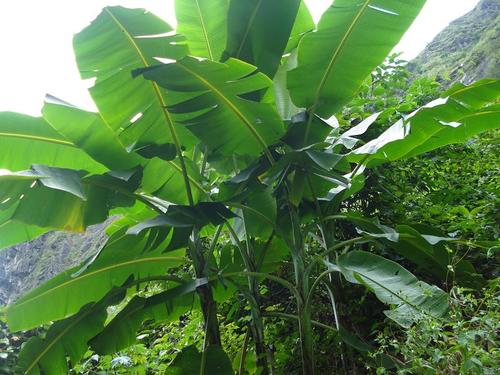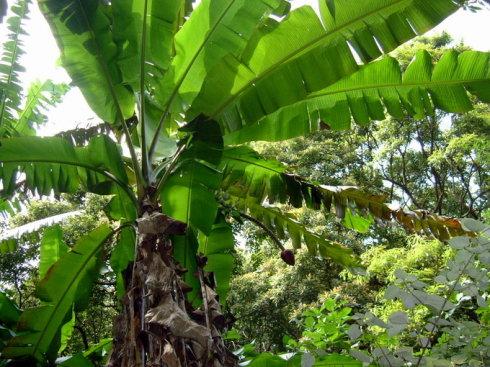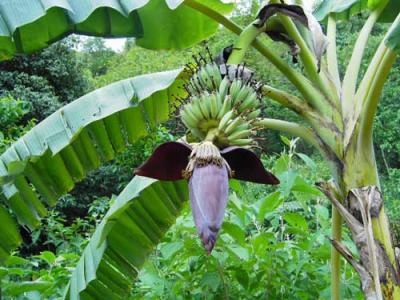Japanese banana (Musa basjoo) profile
Written by admin
Mar 05 2021

Japanese banana, also called Musa basjoo, Japanese fibre banana or hardy banana is a perennial herb known as plantain. Japanese banana leaves are large and oval, the flowers are white, and the fruit is similar to that of a banana. Japanese banana is an evergreen large perennial plants. Stem is 3-4 m tall, unbranched, caespitose.The leaves are large, up to 3 m long and 40 cm wide, oblong in shape, with thick main veins and parallel veins on both sides, light green on the surface and pink-white on the back. In summer, large pale yellow flowers are drawn out of the leaves."Helping trees, quality is not wood, high Shu hanging shade." Japanese Banana is the predecessor of the shape, quality, posture and image description.
Japanese banana has large oval leaves, white flowers and fruit similar to a banana.
Japanese banana picture

Morphological characteristics of Japanese banana
Japanese banana is a perennial herb. The plant is 2.5 to 4 meters tall. Leaves are oblong, 2 -- 3 m long and 25 -- 30 cm wide, apex obtuse, base rounded or asymmetrical, bright green, glossy; Petiole is stout, 30 cm long. Inflorescences of japanese banana are terminal, pendulous; Bracts are reddish-brown or purple; Male flowers are on upper part of inflorescence, female flowers on lower part of inflorescence; Female flowers 10-16 in each bract, arranged in 2 rows; Tepals of Japanese banana are 4 -- 4.5 cm long, with 5 (3+2) dentate lobes, free perianth segments as long as the perianth segments, apically apiculate.
Japanese banana berry tri-rowed, oblong, 5-7 cm long, 3-5 rowed, subsessile, fleshy, with many seeds inside. Seeds are black, verrucous and irregularly angular, 6-8 mm wide.
The ecological habits of the Japanese banana
Japanese Banana is a perennial herb with large, broad leaves, a warm, cold tolerant, strong stem meristem, tolerant to half shade, strong adaptability, and rapid growth.
Japanese banana is ideal for growing in high mountains and dense forests where the land is fertile. Japanese Banana produced in such places is a large, thin skin with tender, sweet, refreshing meat that can help stimulate appetite and digest food. Japanese Banana grows best in loose, fertile, well-ventilated soil; Proper shading is beneficial to plant growth and improve quality.
Japanese banana grows best in deep, loose, fertile, well-drained soil. In winter must maintain the temperature above 4℃, but also can withstand a short time of 0℃ low temperature. Japanese banana is tolerant to half shade, too shade plant growth is poor, difficult to flower. Because its leaves are parallel veins and loose in structure, it is easy to be blown apart by strong winds, soJapanese banana should be planted in sheltered places. Japanese banana likes wet, cultivation should be often watered and sprinkled water to the plant to maintain higher soil and air humidity, but avoid soil continuous water, otherwise it is easy to rot the roots. Planting in addition to the application of sufficient base fertilizer, every month should also be applied decomposed organic fertilizer 1 times to 2 times.
How to grow and care for Japanese banana
Soil
Japanese banana grow well in fertile, well-drained soil.
Water
Water Japanese banana often during farming, keep the soil moist, not too much or too often, so as not to rot the roots. If in relatively dry weather to increase the amount of watering, or often to spray water around, increase the humidity in the air.
Illumination
Japanese banana likes sunshine, so it can be farmed on the balcony. Only when it receives enough light can it grow better. Japanese banana can withstand semi-shade, but if it is kept in too dark environment for a long time, it will not grow well.
Fertilization
In order to make Japanese banana grow better, we should chase fertilizer once a month, apply 1-2 times of organic fertilizer, which can improve the yield of plantain. When applying fertilizer, we should apply thin fertilizer.
Winter care
Japanese banana is generally farmed in front of the window or in the courtyard, so the temperature should be controlled well in winter. It is not cold and can withstand the low temperature of 0℃, but it is better to keep the temperature above 4℃, so that it can pass the winter more safely.
Pruning
In Japanese banana growth period to cut off the yellow leaves in time, so as not to increase nutrient consumption, but also very affect the appearance.

Japanese banana pests and diseases
Pests that can attack include:
Aphids (houseplant)
Borers
Grasshoppers
Mealybugs (houseplant)
Root nematodes
Scales (houseplant)
Spider mites (houseplant)
Diseases that can infect include:
Anthracnose
Mosaic virus
Wilts
Japanese banana division propagation
Japanese banana is usually propagated by dividing plants, and should be carried out in early April. To partition, dig the soil around the Japanese banana with a spade or hoe, exposing the small Japanese banana head and stolon root. Then cut the small Japanese banana head with the stolon root from the mother with a sharp knife. The cut small Japanese banana head is the seedling for partition. If the stolon roots of the seedlings have fibrous roots, they can be directly planted in the courtyard or for potted ornamental.
The distribution of Japanese banana
Japanese banana is native to tropical East Asia.
Japanese Banana is mostly produced in subtropical areas, distributed in Japan, Taiwan, and Shanghai, Hunan, Zhejiang, Hubei, Guizhou, Yunnan, Shaanxi, Sichuan, Jiangsu, Guangxi and other places in the Chinese mainland. Japanese banana grows at an altitude of 500 meters to 800 meters, and often grows in river valleys, village edges and hillside forest margins.
The use of Japanese banana
Ornamental effect
Japanese Banana is a potted, indoor foliage plant with a strange, green, and lovely shape.
Garden use of Japanese banana
Japanese banana is one of the most common trees in classical Chinese gardens.

Latest Updated
- Benefits of Bugleweed - 7 Science-backed Health Benefits
- Bugleweed Dangers & Side Effects - Is It Poisonous?
- How to Plant Evergreen Trees - What You Should Know
- When to Plant Evergreens - Grow Guide for Evergreen Trees
- 12 Wonderful Evergreen Shrubs for Your Garden
- 12 Popular Evergreen Plants with Pictures for Beginners
- When And How To Prune A Lilac Bush Like a Pro
- How to Grow & Care for Lilac Vine (Hardenbergia Violacea)
- Japanese Lilac Tree (Syringa Reticulata) Care & Propagation Guide
- Shumard Oak Pros and Cons - What to Know
Popular Articles
- Winter maintenance of Antirrhinum Majus
- How to Grow Terminalia Mantaly Tree
- How to Grow and Care for Crossostephium Chinense
- How to grow Antirrhinum Majus in spring
- Peristeria Elata (Dove Orchid) Profile: Info & Care Guide
- Underwatered Snake Plant (Sansevieria Trifasciata) - Signs And How To Fix
- How to Care for Brazilian Jasmine Plant (Mandevilla Sanderi)
- How to Grow & Care for Graptopetalum Purple Delight in Summer
- Rosa Chinensis (China Rose): Plant Growing & Care Tips
- How to Care for Baby Sun Rose (Aptenia Cordifolia)